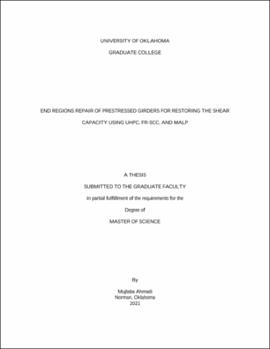| dc.description.abstract | One of the most important concepts in prestressed concrete is stress transfer from prestressing strands to the surrounding concrete. The efficiency of this process dictates the overall quality of the structural member, especially the performance of the end regions where the prestressing force provides a significant contribution to the concrete shear capacity. If this bond is affected due to any factor like vehicular load, collision force, impact, or corrosion due to water penetration from slab joints, the member may lose its shear capacity in that region. Bond loss is not the only factor causing a drop in shear strength. Sometimes the formation of shear cracks close to supports due to overloading also results in minor and moderate damages to the girder. Shear reinforcement may also corrode due to water intrusion from the bridge deck. For scenarios where shear capacity may be affected, the bridge girders can be repaired, or for severe damage, replaced.
In this research, the feasibility of restoring shear capacity by encapsulating the end regions with Ultra-High Performance Concrete (UHPC), Fiber Reinforced Self-Consolidating Concrete (FR-SCC), and Magnesium-Alumino-Liquid Phosphate (MALP) concrete is investigated. This operation does not bring back the lost prestressing force, but it increases the cross-sectional dimensions with higher quality material resulting in a structural retrofit. This repair also produces an impermeable barrier to resist further corrosion damage to the end regions. For this purpose, six approximately half-scale AASHTO Type-II girders were cast, tested, repaired, and tested again to highlight the repair's contribution to restoring the girder shear strength. All the repairs increased the ultimate load capacity of the girders and changed their failure mechanism from a bond-shear failure pre-repair to a bond-flexure post-repair failure. The repair maintained a good bond with the member, indicating an excellent integral behavior of composite material. The research outcome provides the Oklahoma Department of Transportation with a comparison between the performance of the three used repair materials, which can be a very cost-efficient substitute for girder replacement. | en_US |
